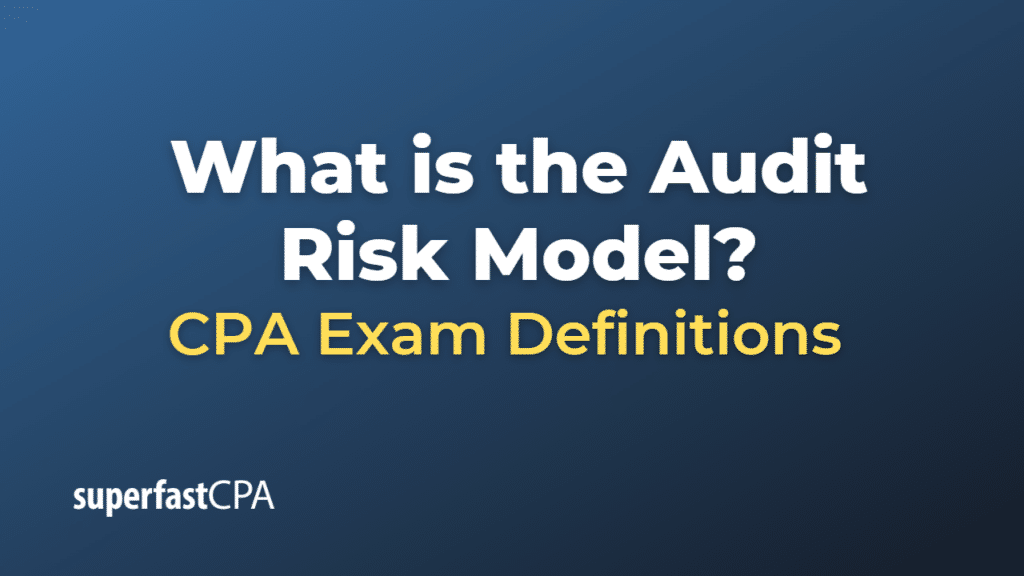Audit Risk Model
The audit risk model is a conceptual framework used by auditors to assess and manage the risk of not detecting material misstatements in the financial statements. The model helps auditors to plan and execute the audit effectively by focusing on areas with higher risks. The audit risk model consists of three components: inherent risk, control risk, and detection risk.
- Inherent risk (IR): This is the risk that a material misstatement exists in the financial statements due to factors such as the nature of the business, the complexity of transactions, and the susceptibility of certain account balances to misstatement, without considering the effectiveness of the entity’s internal controls. Inherent risk is often higher in industries with complex operations, high levels of regulation, or significant estimation uncertainties.
- Control risk (CR): This is the risk that a material misstatement will not be prevented, detected, or corrected by the entity’s internal control system on a timely basis. Control risk is influenced by the design, implementation, and effectiveness of the internal control system. If the internal controls are weak or not operating effectively, the control risk will be higher.
- Detection risk (DR): This is the risk that the auditor’s procedures will fail to detect a material misstatement that exists in the financial statements. Detection risk is influenced by the nature, timing, and extent of the audit procedures performed by the auditor, as well as the auditor’s professional judgment and skepticism.
The audit risk model can be expressed as:
Audit Risk (AR) = Inherent Risk (IR) x Control Risk (CR) x Detection Risk (DR)
Auditors aim to reduce the overall audit risk to an acceptably low level by adjusting the detection risk. If inherent risk or control risk is high, auditors will need to perform more extensive or rigorous audit procedures to lower the detection risk and achieve the desired level of audit risk. Conversely, if inherent risk and control risk are lower, the auditor may be able to perform less extensive procedures while still maintaining an acceptable level of audit risk.
Example of the Audit Risk Model
Let’s consider an example to illustrate the audit risk model in action.
Imagine an auditor has been engaged to audit the financial statements of a manufacturing company called XYZ Ltd. The company has complex operations, involving numerous raw materials, a large number of suppliers, and multiple production facilities. The auditor assesses the following risks:
- Inherent risk (IR): Given the complex operations, the auditor determines that there is a high inherent risk of material misstatements in the financial statements, particularly in the areas of inventory valuation and cost of goods sold.
- Control risk (CR): Upon reviewing XYZ Ltd’s internal controls, the auditor finds that the company has implemented strong controls over inventory management and supplier payments. However, there are some weaknesses in the controls over the costing process. As a result, the auditor assesses control risk as moderate.
With these assessments in mind, the auditor needs to plan audit procedures to address the audit risk. To manage the audit risk, the auditor will need to adjust the detection risk (DR) by designing appropriate audit procedures:
- Since there is a high inherent risk related to inventory valuation, the auditor decides to perform a physical inventory count at year-end, test the accuracy of inventory records, and review the inventory costing methods used by the company.
- In response to the moderate control risk over the costing process, the auditor plans to test the design and operating effectiveness of the related controls, perform substantive testing of cost allocations, and review the company’s standard costing procedures.
By performing these additional audit procedures, the auditor aims to reduce the detection risk and achieve an acceptably low level of overall audit risk. The audit risk model helps the auditor determine the appropriate level of audit procedures to address the risks associated with XYZ Ltd’s financial statements.













